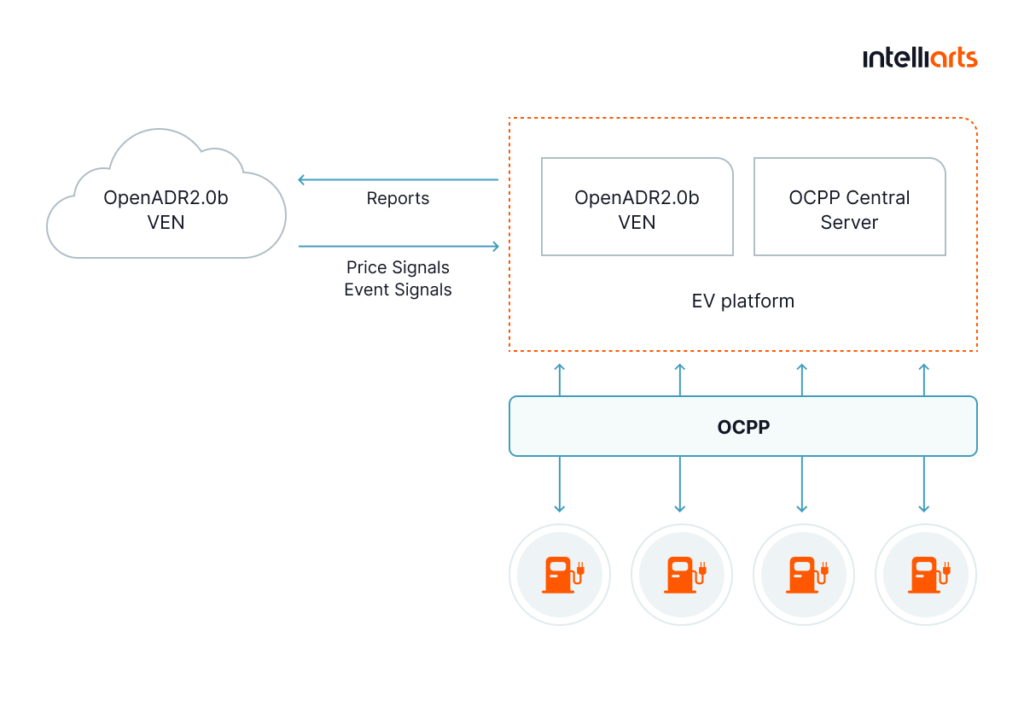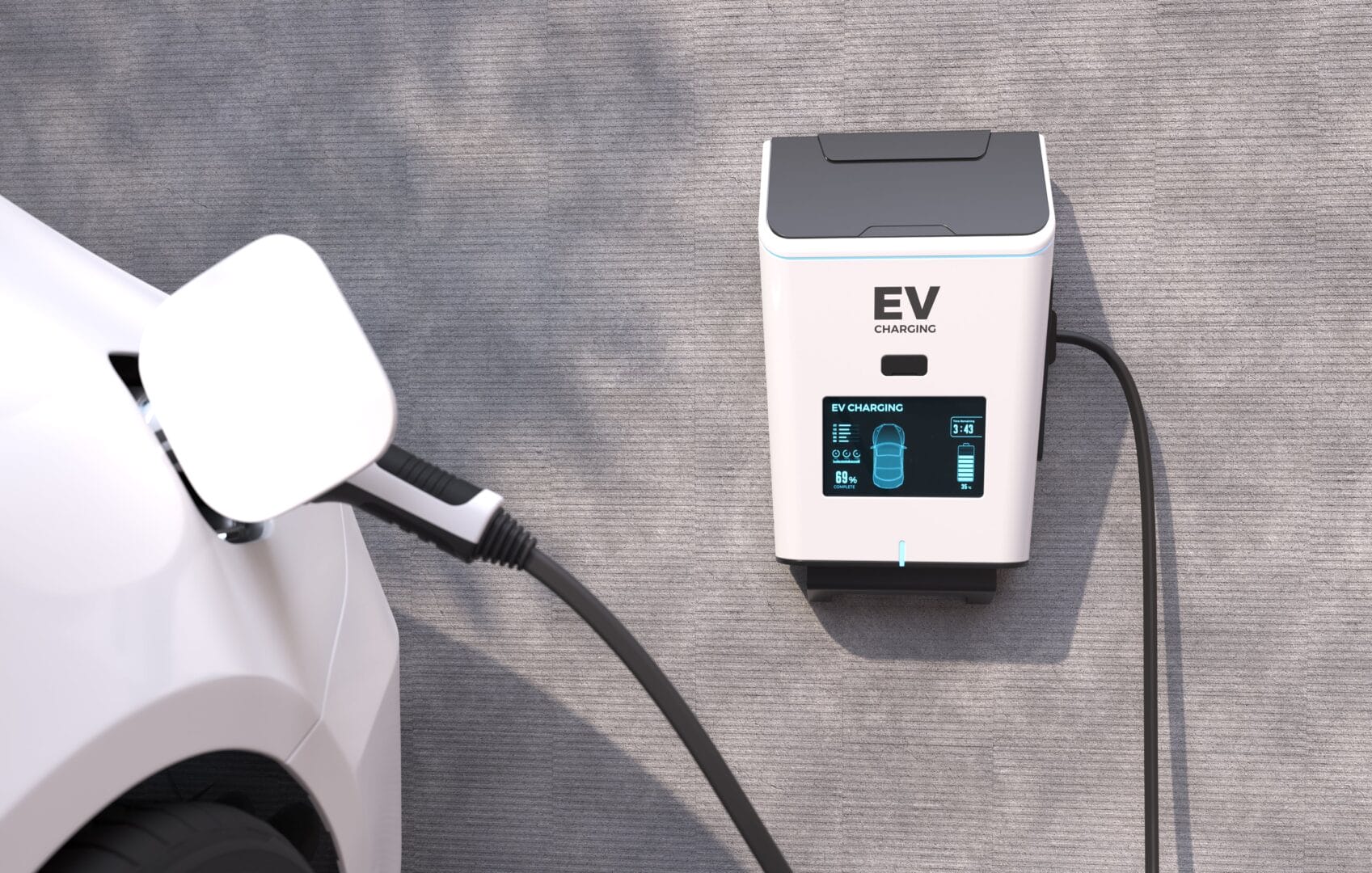Solution Highlights
- Implemented OpenADR to automatically adjust charging schedules at peak hours
- Enabled EV charging stations to operate at off-peak hours and reduce strain on the grid
- Increased power delivery efficiency and allowed site hosts to optimize energy consumption
- Saved costs by avoiding charging EVs at peak hours and delaying expensive grid updates

About the Project
Customer:
EV Connect is a top electric vehicle (EV) charging management software solution provider in the US market. The company enables a comfortable end-to-end charging experience offering to its site hosts turn-key certified charging stations, a state-of-the-art software platform, and a trusted EV driver app. But their real superpower is 24/7 premium customer service and meaningful insights and usage data.
Intelliarts has collaborated with EV Connect for the last few years, being in charge of the development of EV charging management solutions. Together, we have worked on a range of challenging renewable energy projects to contribute to our partner’s value chain.
Challenges & Project Goals:
Despite their benefits like zero fuel costs and reduced air and noise pollution, EVs have their limitations too. One of the drawbacks of EVs is the potential to overload the grid, and as the number of EVs increases, they put an extra burden on the electrical grid.
EV Connect wanted to mitigate this risk of overloading the grid and, hence, add to their value proposition. Our partner enlisted the support of the Intelliarts team to implement the Open Automated Demand Response (OpenADR) for smart grids, the idea of which is to manage the ever-growing demand for charging at peak hours. By providing signals to EV charging stations, this technology helps them operate at off-peak hours and reduces the strain on the grid.
Solution:
By joining efforts with the customer, Intelliarts implemented the OpenADR 2.0b specification that allows an automated and secure two-way communication between the electricity suppliers and site hosts to dynamically manage electricity demand in real-time. In the long run, this solution can benefit site hosts with saved costs and optimized energy use while also increasing the efficiency of power delivery across smart grids.
Cloud Services, SaaS Development, IoT Solutions
Technology Solution
Throughout our collaboration with EV Connect, we focused on implementing the OpenADR 2.0b specification and using it for energy load management.
OpenADR represents a non-proprietary, open standard interface for Demand Response (DR). In the energy sector, DR programs are initiated by grid operators to ease pressure on the electricity grid at peak times. Serving as a gold smart grid standard, OpenADR helps to send data and DR signals to shut down electrical devices, such as EV stations, in periods of high demand.
In the project, our specialists implemented OpenADR 2.0b Profile Specification as the latest version of this communication standard. Our software engineers then proceeded with the certification of VEN implementation in OpenADR Alliance.
To explain it in more detail, the main elements of an OpenADR-enabled program include a Virtual Top Node (VTN) and Virtual End Node (VEN), where:
- VTN functions as the server residing on the load aggregator/utility side and transmits OpenADR signals to end devices.
- VEN serves as the client operating on the device side and receiving communication from the VTN. It accepts the OpenADR signal from VTN, transmits the message to the devices further, and gets back to the server with any relevant information, including device participation details, opt-outs, etc.
So our next logical step was VEN integration with our partner’s charging station management platform. Some milestones of this integration included:
- Building logic mapping for DR events at charging stations.
- Implementing load management algorithms used for DR. For those stations that used the OCPP 1.6 communication protocol, we applied charging profiles. Our specialists chose a different approach for the stations that still used a closed protocol. Since these stations didn’t have a smart load management system for EVs and were supported only with the help of pause/resume commands, we built an algorithm that periodically paused and started charging at these stations.
- Adding notifications about upcoming DR events for site hosts. We also made it possible for site hosts to refuse to participate in certain events.
- Building driver notifications to let them know if a station is under or near a DR event so the charging would take more time. So when the driver logs into the application, the system checks the station status and then notifies the driver that it may reduce either the station’s output or duty cycle depending on the load management strategy chosen by the site host on this location.
- Integrating with utility companies’ VTNs and enabling site hosts to add locations and stations under utility programs. Later, we added the possibility to connect one VEN instance with many VTNs, though in the original implementation, a new instance had to be raised for each new integration.
- Adding reporting for utility companies, including information about stations involved in the DR program, charging sessions, the amounts of energy consumed, maximum and minimum power, intervals, etc. Users could manually download these reports and automatically send them to the customer’s FTP. Moreover, our software engineers built the reports highly customizable, so users could choose which fields to send, how to name the fields and files, etc.
Later, our team also used OpenADR to implement the EV energy management solution, another solution that Intelliarts developed for the same customer. The first energy management system was actually written within the scope of the OpenADR project.
So after the OpenADR implementation, the customer experience looked like the following:
- A network administrator, together with our development team, establishes the initial configuration between our server and the OpenADR server. As new sites enroll in the OpenADR utility program, they are added to the list of locations served by the program.
- Site hosts get notified when load limitations are close or active, and they also know to which extent their chargers would be limited.
- Depending on their early choice, site hosts should get an opportunity to enable or disable the option for drivers to opt out of the DR event or automatically be forced to adjust the pricing policy.
- Our partner can choose locations within a specific utility company profile, generate a session data report for it, and download it.
- By using the mobile application, EV drivers can check the upcoming load shifts for a specific location and any surges in pricing.
Business Outcomes
The OpenADR protocol implementation was a big step forward for EV Connect and lots of other stakeholders, including site hosts as their end users, EV drivers, and utilities and energy service providers.
So, the value that the project brought was:
- Increased energy efficiency: Technology empowered our partner to reduce energy consumption during times of peak demand. Respectively, it allowed users to save on electricity bills as well as to maximize value by customizing their energy needs. EV fleets benefited from the solution most as they usually consume more energy as compared to individual EV drivers. Through the OpenADR interface, the system automatically adjusts the charging schedules so EVs are charged when the demand is low.
- Grid reliability: OpenADR also guaranteed a more predictable DR resource for utilities to use during times of grid stress. This helped the grid, making it more responsive and adaptable. Also, the combination of OpenADR with OCPP (Open Charge Point Protocol) was especially useful for our partner’s EV fleet management system by making it more flexible without the need for human intervention.
- Saved costs: By avoiding peak demand times, EV drivers and fleet owners save money and can get some incentives. In turn, utility companies and energy service providers save on maintenance and expensive grid updates.
- Eco-friendliness: Lots of US states have adopted peak load reduction goals, and these are more easily achievable with OpenADR-based solutions. The OpenADR-enabled system provides greater and more consistent kW reduction rather than other approaches so utilities can meet their peak reduction targets more efficiently.














